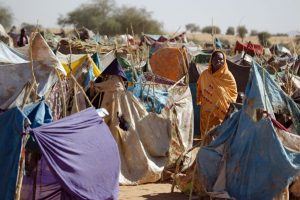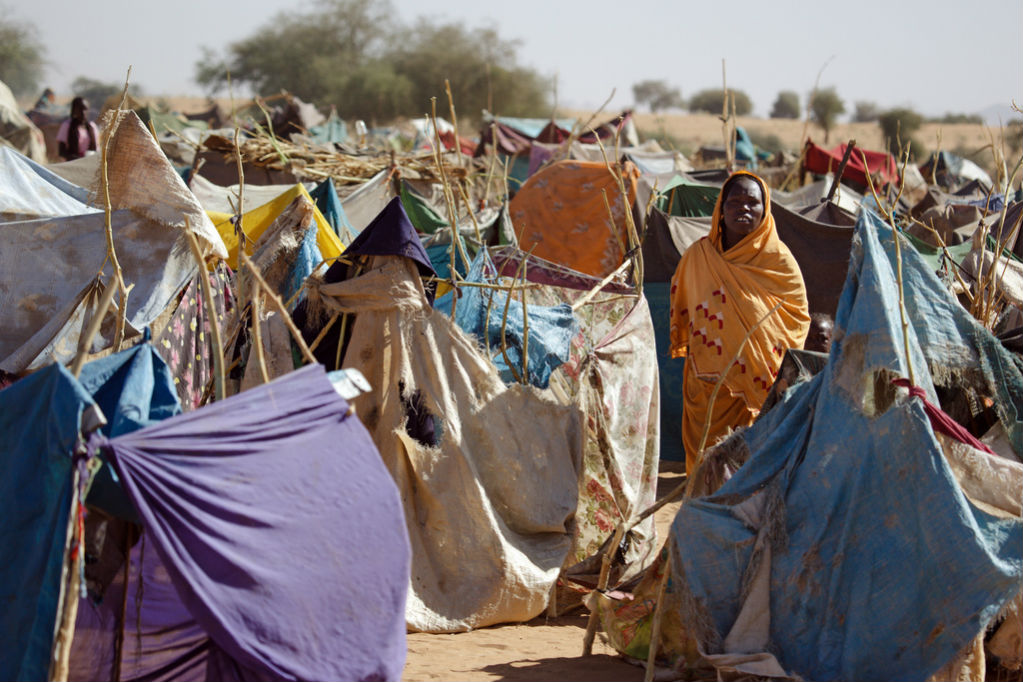
By Eric Reeves
October 23, 2017 (SSNA) — As far back as the summer of 2004 plans for the “return” of displaced persons were being considered, and mendacious public announcements by senior NIF/NCP officials spoke of “returns” as in full swing—a crude effort at making something so by declaring it so. Abdel Rahim Mohamed Hussein, then Minister of the Interior and the regime’s special representative on Darfur, announced on Sudanese government-controlled radio on July 9, 2004 “that 86 percent of the Internally Displaced Persons had already returned to their villages” (UN Integrated Regional Information Networks, July 12, 2004). Hussein further declared that “it was ‘most important’ to get people to return to their villages. Each state—the Darfur region has three—had its own plan of return.”
At the time camps for displaced persons in Darfur held more than 1 million people—leaving aside the large number of refugees (today this a population of approximately 320,000 according to the UN High Commission for Refugees). Presently, the UN Office for the Coordination of Humanitarian Affairs, which has frequently been either unreliable or badly out of date with its figures for internally displaced persons (IDPs), provides data indicating that the number of IDPs in all setting is approximately 2.7 million (see | http://sudanreeves.org/2017/03/19/internally-displaced-persons-in-darfur-the-invisible-catastrophe/).
Here it seems appropriate to recall that Hussein, the man speaking so callously of Darfuri IDPs, has been indicted by the International Criminal Court for massive crimes against humanity in Darfur. But there have been many statements such as his subsequently; indeed, in the closing days of 2015, Vice-President Hassabo Mohamed Abdelrahman was reported by Sudan Tribune as making clear the regime’s view of the IDP camps:
In a speech delivered before the representatives of former rebel groups and IDPs in El-Fasher, North Darfur on Monday, [Second Vice-President Hassabo Mohamed Abdelrahman] said Darfur has “completely recovered from the war and is now looking forward to achieve a full peace, stability and development.”
“IDP camps represent a significant and unfortunate loss of dignity and rights of citizens in their country” he said and called on the displaced “to choose within no more than a month between resettlement or return to their original areas.”
He further reiterated his government’s commitment to take all the measures and do the needful to achieve this goal, stressing that “the year 2016 will see the end of displacement in Darfur.” Abdel Rahman told the meeting that he has just ended a visit to Karnoi and Tina areas in North Darfur, adding the two areas which were affected by the conflict have totally recovered. He said his visit with a big delegation to the two areas “is a message sceptics in the fact that security and stability are back in Darfur”… (Sudan Tribune, December 28, 2015 | El Fasher, North Darfur)
Hassabo’s statement came a matter of days before Khartoum would launch the massive 2016 military offensive against the Jebel Marra massif in the center of Darfur. As many as 200,000 people were newly displaced in that campaign, perhaps more—humanitarian access even now not been sufficient in parts of Jebel Marra to allow for a full census. The claim by Hassabo that “security and stability are back in Darfur”—on the very eve of the Jebel Marra offensive, during which chemical weapons were used against civilians—is mendacity entirely in character for the regime.
We should also recall Hassabo’s attitude toward the non-Arab/African civilians of Darfur prior to one of the massive assaults in Eastern Jebel Marra (primarily in North Darfur), here as reported by Human Rights Watch in September 2015. Here is Hassabo directly addressing several hundred army and Rapid Support Forces (RSF) soldiers in December 2015, the beginning of the “dry season campaign” (as reported to Human Rights Watch by a defecting militiaman):
“Hassabo told us to clear the area east of Jebel Marra.
To kill any male. He said we want to clear the area of insects…
He said East Jebel Marra is the kingdom of the rebels.
We don’t want anyone there to be alive.”
(“‘Men With No Mercy’: Rapid Support Forces Attacks against Civilians in Darfur, Sudan,” Human Rights Watch, September 9, 2015 | https://www.hrw.org/report/2015/09/09/men-no-mercy/rapid-support-forces-attacks-against-civilians-darfur-sudan/)
It is difficult to imagine much compassion will be extended by such a man to those who live such tenuous lives in the IDP camps, now threatened. And with the Khartoum regime’s current arms collection effort in Darfur—soon scheduled to be conducted by force, as opposed to the “voluntary” collection now underway—Hassabo and the regime have created what they certainly regard as adequate pretext for assaults on camps where they have repeatedly claimed weapons are being harbored. This claim, however, does little to explain why those in the camps for displaced do not respond to violent assaults—of which there have been many—with the weapons they are supposedly harboring.
In February 2017 Radio Dabanga reported on an explicit threat of camp dismantling:
14,000 displaced given days to vacate South Darfur camp | February 17, 2017 | KALMA CAMP | The Commissioner of Nyala locality in South Darfur has given the 14,000 residents of Centre 4 of Otash camp near the state capital less than a week to vacate it before it is dismantled. The spokesman for the Association of Displaced Persons and Refugees, Hussein Abusharati, told Radio Dabanga that a Land Cruiser mounted with a Dushka machine gun drove into the camp on Thursday afternoon. “It moved through the camp using a loudspeaker, calling on the displaced to evacuate the camp by February 22, without specifying an alternative place for the displaced to live.
The association denounced the Commissioner’s decision and held Government responsible for the implementation of the decision. It renewed its refusal to dismantle the camp, and conditioned the return of displaced persons to their home by provision of security and stability in their villages.
Abusharati warned of “dire consequences should the decision be implemented by force.” He called on state government “to cancel the decision so as to preserve the lives and property of the displaced.” He urged the residents of Centre 4 to approach UNAMID should the commissioner order the camp to be forcibly evacuated. He called on UNAMID, the international community, and human rights organisations to protect the displaced of camp Otash “so that there will not be a repeat of the massacre that occurred at Kalma camp in 2008.”
Abusharati was referring to an infamous incident in August 2008 when police attempted to enter Kalma campo by force, leaving 32 displaced people dead (see | “Now Sudan Is Attacking Refugee Camps,” The Wall Street Journal, 6 September 2008 | http://online.wsj.com/article/SB122065894281205691.html?mod=googlenews_wsj/). There was no follow-up report from Radio Dabanga on the fate of Otash camp center 4; nor was there a response from the feckless UNAMID or, more consequentially, the Western actors of consequence so eager to accelerate the process of rapprochement with Khartoum.
But Kalma camp was attacked again in deadly fashion just a month ago, with five killed and more than twenty-five wounded (see my account, based on Radio Dabanga and Sudan Tribune accounts, at | http://sudanreeves.org/2017/09/22/yet-again-kalma-camp-south-darfur-for-displaced-persons-is-the-scene-of-deadly-violence-by-khartoums-security-forces/ ). And as if to underscore the connection between the regime’s insistence that the camps be dismantled and people return “home” (even if those homes no longer exist and their lands have been violently expropriated by Arab militias and armed groups), at the same time that Kalma was being attacked, in nearby Nyala (the largest city in Darfur) President and ICC-indicted génocidaire Omar al-Bashir was speaking about people “returning to their villages of origin” (“South Darfur camp protest turns deadly, UNAMID calls for restraint” | Radio Dabanga | https://www.dabangasudan.org/en ] September 22, 2017 | NYALA).
A merely perfunctory statement from the Trump administration was particularly significant—and encouraging to Khartoum—given the terms laid down for a lifting of sanctions on Khartoum when the Obama administration perversely decided on this action in its last week in office. “Humanitarian access” was to have been one of the key terms of any assessment of Khartoum’s behavior, both in the six months prior to Obama’s decision and the six months following.
Now that sanctions have been lifted, it is highly unlikely that serious attention will be paid to the issue of humanitarian access: we have only to look at the continuing humanitarian embargo imposed on civilians in SPLM/A-North-controlled areas of South Kordofan and Blue Nile to see how little the issue of humanitarian access has really mattered to the Trump administration—or to the Europeans so eager to enlist Khartoum as an ally in stanching the flow of African migrants to the European continent.
What is all too clear is that if the IDP camps are emptied and dismantled, “humanitarian access” in any meaningful sense will be almost entirely eroded. The concentrations of large populations in these camps are all that make the distribution of food and medicine possible, as well as the provision of clean water, shelter, and a modicum of security. If people are forced from the camps with no place to go, they will either perish or be forced to seek refuge in other camps—camps that may themselves be in the dismantling cross-hairs. Khartoum is of course aware of this, but relentlessly seeks to end the rationale for an international humanitarian presence in Darfur—and emptying the camps is the most efficient way of doing so.
Camp emptying and dismantling will also give Khartoum an argument for the further withdrawal of the impotent but (for Khartoum) noisome presence of the UN/African Union “Hybrid” Mission for Darfur (UNAMID). Khartoum pushed hard for the withdrawal of UNAMID from Darfur when the issue of the Mission was before the UN Security Council in June. The UNSC “re-authorization” of UNAMID cut 44 percent of the military personnel in the force and 30 percent of the police personnel. The force has already been cut severely from its originally mandated size, but because it has proved so ineffective while being terribly costly, there has been diminishing support for any meaningful continuation of UNAMID. Certainly there seems to be almost no enthusiasm for the kind of meaningful civilian protection argued for in compelling terms a year ago by Jonathan Loeb, primary researcher and author for the last three significant human rights reports on Darfur (see “Time to Get Serious about Civilian Protection for Darfur” | NEW YORK, December 20, 2016 (IPS)/).
If the dismantling and emptying of camps has not yet officially begun, the increasingly strident rhetoric and increasingly insistent threats of action make clear that it is only a matter of time before Khartoum does act. The attack on Kalma camp a month ago give us a preview of what will be increasingly common as a gutted UNAMID continues its deployment out of Darfur. UNAMID’s withdrawal of its feeble “eyes on the ground,” along with the surrender of its military posts to Khartoum, may well be the catalyst for that action, with a cascade of knock-on effects that portend disaster on an inconceivably large scale.
The moment of truth will come when in a matter of days arms collection in Darfur, carried out by an increasingly large presence of the notorious Rapid Support Forces—now Khartoum’s militia force of choice and officially part of the regime—becomes compulsory. The stage will have been set for violence of unspeakable nature against displaced, overwhelmingly non-Arab/African Darfuris. The genocide continues.
Eric Reeves is Senior Fellow at Harvard University’s François-Xavier Bagnoud Center for Health and Human Rights.

